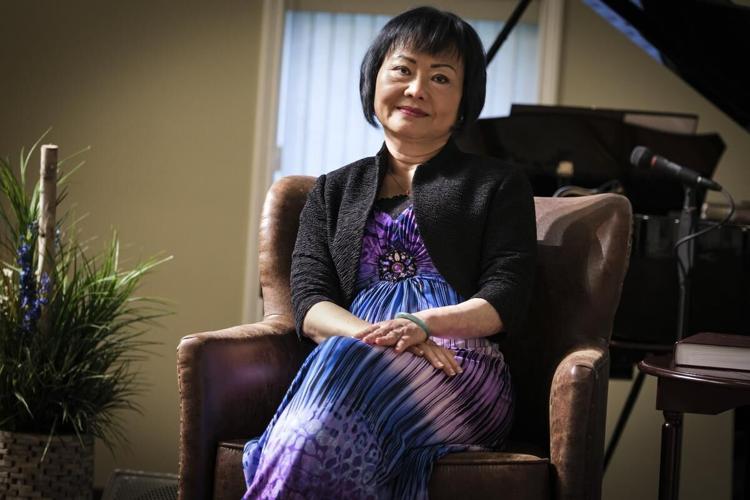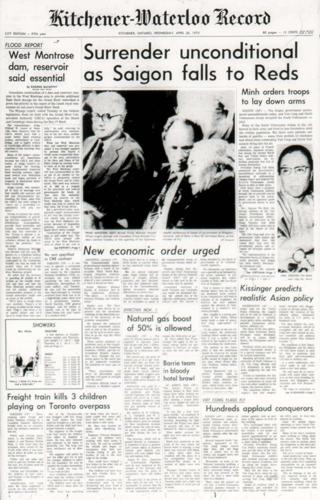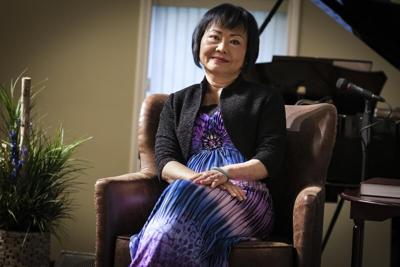When nine-year-old Kim Phuc was caught in a napalm strike in June 1972 near her home in South Vietnam, she ripped the burning clothes from her body and ran into the history books.
The scene was captured by photographer Nick Ut, becoming one of the most famous images of the 20th century — a record of the brutality of America’s war in Vietnam, which ended 50 years ago today.
“As a little girl, I hated that picture,” said Phuc in an interview.
Phuc will receive an honorary doctorate in laws from Wilfrid Laurier University at the main campus June 2 as part of the spring graduation ceremonies. She is a high-profile reminder of the thousands of ways the Vietnam War impacted Canada.
Thousands of young American draft dodgers came here to avoid fighting in the jungles of Southeast Asia, the chemical plants in Elmira made the toxic defoliant Agent Orange that was sprayed over South Vietnam, more than 200,000 Vietnamese refugees came to Canada between 1975 and 1990 and there is now a thriving cluster of Vietnamese-owned business along King Street East in Downtown Kitchener.
Phuc came to Canada in October 1992 and settled in the Toronto area. For a few years, she enjoyed her anonymous life in Toronto. After she was badly burned by napalm in June 1972, Phuc spent 14 months in hospital and was in near-constant pain. About 10 months after she was released from hospital, the North Vietnamese Army rolled into Saigon and the war was over.
But for Phuc, the war dragged on for years.
“Nine years old, I had no choice in what happened to me, the picture was taken, my life was turned upside down,” said Phuc.
She stayed in school and was eventually admitted into pre-med studies. When the Communist government learned “The Girl in the Picture” was living and studying in Saigon, they pulled her out of school. Instead of studying, she was told to provide an endless series of interviews to foreign reporters and documentary film crews visiting Vietnam.
“They cut short my studies to use me for their propaganda,” said Phuc.

In this June 8, 1972, photo, crying children, including nine-year-old Kim Phuc, centre, run down Route 1 near Trang Bang, Vietnam, after an aerial napalm attack on suspected Viet Cong hiding places as South Vietnamese forces from the 25th Division walk behind them. A woman who came to symbolize the horrors of the Vietnam War is being honoured at Wilfrid Laurier University this spring, the 50th anniversary of the end of the Vietnam War.
Nick Ut / AP“This was a really low point in my life,” said Phuc. “I lost my dream, I lost my hope, I lost my future, because as a student, that was my dream, to go to school, to fulfil my career and I had a big, big dream, I wanted to become a doctor.”
When she wasn’t giving interviews, Phuc spent her time in a public library in Saigon, renamed Ho Chi Minh City. Growing up in Tây Ninh province, Phuc was raised in the Cao Dai faith. But in the books of that library, she started reading about Christianity. The Bible’s ideas of forgiveness and Christian love — love your enemies as much as you love yourself — changed her life. In 1982, she converted to Christianity.
Eventually, the Communist Party in Vietnam sent Phuc to Cuba for more education. That’s where she met the man she would marry, and when the two were on a flight from Cuba, they defected during a refuelling stop in Gander, Newfoundland, in October 1992. They became Canadian citizens in 1998.
...
Among the 8,000 to 10,000 Vietnamese residents in Kitchener-Waterloo and Cambridge are Phong Tran and his wife Dawn (Thuy) Tran, née Dung. They own the Matter of Taste café on King Street West, which they opened in 2004. They were both children when the North Vietnamese Army captured Saigon on April 30, 1975.

“Last Day in Saigon” — A United States Marine helicopter takes off from the heli-pad on top of the American Embassy in Saigon (now Ho Chi Minh City), Vietnam, on April 30, 1975, as American personnel evacuated. The Vietnam War ended 50 years ago today.
AP file photoDung’s father was in the South Vietnamese military — created, funded, trained and equipped by the Americans — so he had no choice but to flee after the North Vietnamese victory. He could have fled with the Americans, but would not leave his family behind. Dung’s father secured a fishing boat, loaded everyone on board and took his family to Malaysia. They drifted for two days after the motor broke down, but her uncle managed to repair it and they resumed their desperate journey.
Her aunt was not so lucky. The boat she was travelling in was attacked by pirates who robbed them, killed all the men and left the women and children on their own in the South China Sea. They eventually made it to Malaysia as well.
Dung’s family came to Canada in 1981, landing in Edmonton in the middle of winter.
“Just imagine, we arrived in summer clothes,” said Dung.
Tran’s family story is different. Six years after the war ended, on New Year’s Day, Tran’s family was standing beside a street in Saigon waiting to cross. A military truck jumped the curb and ran down the family. Tran was pronounced dead at the scene, but revived. His mother was severely injured. His father was unhurt, even though he had tire tracks over his chest.
After his parents sued the government, the family was harassed by officials. So they came to Canada in 1984 when he was 14. They arrived in Ottawa in November 1984.

Canadians protest the Vietnam War in 1967 outside Queen’s Park in Toronto. April 30 marks the 50th anniversary of the end of the war.
Toronto Star Archives photo The StarThe 50th anniversary of the end of the war will highlight the differences among the Vietnamese community here.
“There are two trains of thought in the Vietnamese community,” said Tran. “There is the move-on people, and the ones still hanging onto the past.”
Tran and Dung are part of the move-on group.
“We look at it and understand it, but we move on, the other group are very much holding onto the past, they still fly the old flag, they curse the Vietnamese government,” said Tran.
When workers, companies and the provincial government were fighting about compensation for workers who developed cancer after being exposed to Agent Orange in the chemical plants in Elmira, Tran got angry. The toxic defoliant laced the soil in South Vietnam with dioxin, causing widespread birth defects and cancers, and left the once-lush jungle looking like a tinder-dry lawn.
“It was never cleaned up, it is still like that,” said Tran. “No compensation. You can drive in the countryside, and you can still see that.”

Women with babies look for relief. Jack Cahill of the Toronto Star took gripping photos as he covered the war in Vietnam.
Jack Cahill / Toronto StarIn this area, there are organizations for Vietnamese Catholics, Buddhists, one that is secular and a fourth that refuses to recognize the communist rulers of Vietnam that won the war.
Dung’s father, a former member of the South Vietnam military, is now a Buddhist monk with a mediation centre in a forest near Tweed in Eastern Ontario. He has found peace, and helps others do the same.
“Any students who come to him that are still in limbo, he says: ‘Make peace with it, don’t live in the past, it is the past, things have happened, so move on, what are you going to do with your life, right now you are here, you are safe, you are one of the lucky people who got out safe, the time and opportunity that you have, take this and build something positive out of the hardship and the suffering,’” said Dung.
...
Kim Phuc found her way to peace. After marrying, her full name became Kim Phuc Phan Thi. The couple started a family in Canada. But that 1972 photograph changed her life again.
Two British reporters found her in Toronto, took her picture and published a story in 1995 about Phuc, her husband and child living quietly in Toronto. With her baby in her arms and the newspaper spread on the table before her, the young mother thought hard about her life.
“The more I looked at that picture, the more I looked at my child — wow — something moved me to the point: ‘Kim, you cannot run from your picture forever, you cannot escape that,’” said Phuc.

A Kitchener-Waterloo Record newspaper front page dated April 30, 1975, scanned from microfilm, with the headline “Surrender unconditional as Saigon falls to Reds: Minh orders troops to lay down arms.” The Vietnam War ended 50 years ago today.
She started the KIM Foundation to help children around the world who are victims of war. In 2017 she published a memoir, “Fire Road: The Napalm Girl’s Journey through the Horrors of War to Faith, Forgiveness, and Peace.” Phuc was made a UNESCO peace ambassador.
“I love the way I am doing now,” she said.
“I could not escape that picture forever, because that picture defined me. I can use that destiny to help people.”
She and her husband moved to Ajax, had more children and work to help children hurt by conflicts around the world.
“Now, I look at that picture after 53 years, wow, as a powerful gift for me,” said Phuc.
“I am so grateful that Nick Ut, the photographer who took my picture in that moment, he is my hero.”

































To join the conversation set a first and last name in your user profile.
Sign in or register for free to join the Conversation